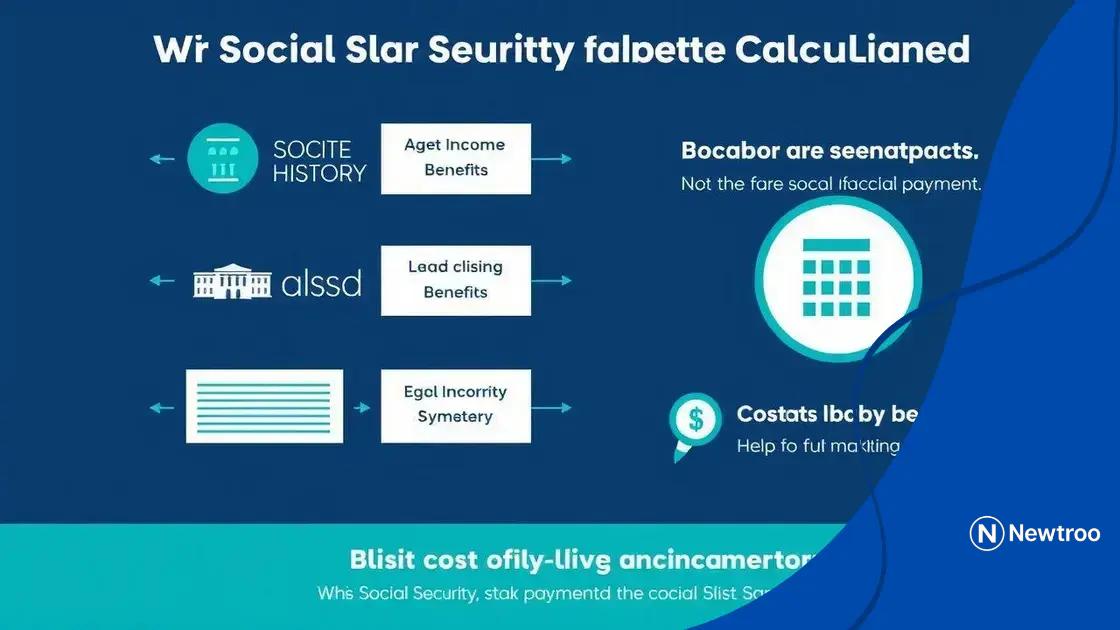Social Security payment dates announced: What you need to know

Anúncios
Social Security payment dates are determined by your birthday, with payments issued monthly on specific Wednesdays, and understanding how benefits are calculated is essential for effective financial planning.
Social Security payment dates announced are more than just numbers on a calendar; they directly influence how you manage your finances. Curious about when you can expect your benefits this year? Let’s dive into the details.
Anúncios
Overview of Social Security payment schedule
Understanding the Social Security payment schedule is essential for beneficiaries. These payments provide necessary income, and knowing when to expect them is crucial for planning your finances.
Payment Schedule Basics
Social Security payments are typically made on a specific schedule. For most beneficiaries, these payments arrive monthly. The day of the month you receive your payment depends on your birthday. Here is a breakdown:
- If your birthday falls between the 1st and 10th, you receive your payment on the second Wednesday of each month.
- Those with birthdays from the 11th to the 20th receive payments on the third Wednesday.
- If your birthday is from the 21st or later, your payment comes on the fourth Wednesday of the month.
This schedule is important to keep in mind, as it allows you to budget accordingly. The regularity of these payments can help you manage monthly expenses with more ease.
Anúncios
Factors Affecting Payments
Several factors can influence how much you receive in Social Security payments each month. The most significant of these is your work history and the age at which you begin to take benefits.
Here are key points to consider:
- Your earnings over your working life play a major role in determining your benefit amount.
- Claiming benefits before full retirement age can reduce your monthly payment.
- Cost-of-living adjustments (COLA) may occur annually, potentially increasing your payment amount.
Being aware of these factors allows beneficiaries to make informed decisions about when to start receiving Social Security benefits. Being prepared helps to maximize the financial resources available to you.
In summary, grasping the Social Security payment schedule and the factors affecting your benefits is fundamental for effective financial planning. By understanding this schedule and what influences it, you lay a solid foundation for managing your finances efficiently.
Key dates to remember this year
This year, there are key dates to remember for Social Security payments that can help you stay on top of your finances. Being informed about these dates ensures you plan effectively for your monthly expenses.
Important Payment Dates
For 2023, payments will typically follow the same schedule as in previous years. If you are a recipient of Social Security benefits, it’s vital to mark these dates on your calendar:
- January 11: First payment of the year.
- February 8: Payment arrives for beneficiaries born between the 1st and 10th.
- March 8: Payment for those born between the 11th and 20th.
- March 22: Last payment of the month for those born after the 20th.
Understanding these payment dates helps you manage your budget more effectively. Each month, payments are consistently delivered, allowing for easy planning around these times. Keep a close eye on your calendar to avoid any potential surprises.
Additional Considerations
Besides the set payment dates, you should consider other factors that might affect when you receive your funds. For instance, if a payment date falls on a holiday or weekend, the payment might arrive a day earlier. Always check for potential changes in the schedule.
Further, it’s important to monitor for any adjustments to the payment amounts. The cost-of-living adjustments made annually can change how much you receive, impacting your financial planning.
Planning around the key dates ensures that you are prepared and can manage your finances without stress. Keep these dates in mind as you navigate your budgeting and spending throughout the year.
How payments are calculated

Understanding how payments are calculated for Social Security is crucial for beneficiaries. This process is influenced by several factors, including your income history and the age you choose to claim benefits.
Income History
Your earnings throughout your working life play a significant role in the calculation of your monthly benefits. The Social Security Administration (SSA) looks at your highest 35 years of indexed earnings to determine your average indexed monthly earnings (AIME).
- This method ensures that higher earnings years have a more significant impact.
- Lower income years might be excluded from the calculation altogether.
- It’s essential to keep records of your earnings to verify accuracy.
Once your AIME is established, the SSA applies a formula to derive your primary insurance amount (PIA). This amount is the benefit you will receive at your full retirement age.
Claiming Age
The age at which you decide to start receiving benefits also affects your monthly payment. You can claim as early as age 62, but if you do, your payments will be permanently reduced. Here’s how it works:
- If you claim early, you can lose up to 30% of your monthly benefits.
- Delaying your claim past your full retirement age can increase your payment, up to a maximum of 8% for each year you wait.
- Choosing the right age to start claiming is a significant decision that can impact your financial situation for years to come.
Additionally, factors such as cost-of-living adjustments or COLA will apply annually, potentially increasing your overall benefits. Understanding these calculations empowers you to make informed decisions about your Social Security benefits and plan effectively for your future.
What to do if you miss a payment
If you find yourself in a situation where you’ve missed a Social Security payment, it’s important to stay calm and take action promptly. Understanding what to do next can help you resolve the issue quickly.
Steps to Take Immediately
First, confirm if you actually missed a payment. Payments may be delayed or not arrive on the expected date due to holidays or weekends. If a payment is not received, follow these steps:
- Check your bank account for deposits; sometimes the payment may arrive a day later than expected.
- Review your payment schedule, and ensure you are aware of when payments are typically made.
- If you still don’t see your payment, contact the Social Security Administration (SSA) to inquire about the situation.
When reaching out to the SSA, have your personal information ready, such as your Social Security number and details about your missed payment. This information will help them assist you more efficiently.
Possible Outcomes
Once you’ve contacted the SSA, they will investigate the issue. They might find that a payment was processed but not properly deposited, or they may acknowledge a delay in processing.
- In some cases, they may issue a replacement payment to resolve the situation.
- If the missed payment was due to a change in your benefits, the SSA will provide information on how to address it.
- Be sure to ask about the next steps and any actions you may need to take.
To avoid missed payments in the future, consider setting up alerts or reminders. Keeping a budget can also help you manage your finances better and allow for planning around potential delays. Understanding these steps is key to navigating the system and ensuring you receive your benefits on time.
Additional resources for beneficiaries
Beneficiaries of Social Security have access to various additional resources that can help them navigate the complexities of managing benefits. Knowing where to find assistance can significantly ease the process of understanding your rights and options.
Social Security Administration Resources
The Social Security Administration (SSA) provides numerous tools and resources for beneficiaries. On their official website, you can find:
- Online Services: Access to your personal Social Security account, benefit statements, and payment history.
- Help Center: FAQs, downloadable forms, and essential information about benefits.
- Local Offices: Locate a nearby office for in-person assistance, should you prefer to speak with a representative.
Utilizing these tools can empower you to make informed decisions about your benefits and ensure that you receive the assistance you need.
Support Organizations and Advocacy Groups
In addition to SSA resources, many advocacy groups offer support tailored for Social Security beneficiaries. These organizations can provide valuable information, assistance with applications, and guidance on various issues.
- Aging Services: These organizations can assist seniors in understanding their benefits and rights.
- Legal Aid Services: Free or low-cost legal assistance for resolving disputes or issues with Social Security payments.
- Financial Counseling: Professional help in managing income from Social Security and budgeting strategies.
Being aware of these organizations can provide further support and resources, enhancing your ability to navigate through any challenges you might face.
In conclusion, exploring these additional resources is essential for any Social Security beneficiary. They can make a significant difference in understanding your rights, maximizing your benefits, and ensuring your financial well-being.
FAQ – Frequently Asked Questions about Social Security Payments
What should I do if I miss a Social Security payment?
Check your bank account for delays, review your payment schedule, and contact the SSA for assistance if necessary.
How are Social Security payments calculated?
Payments are based on your highest 35 years of earnings and are determined by your average indexed monthly earnings (AIME).
When can I expect my Social Security payments?
Payments are typically scheduled based on your birthday. If your birthday is between the 1st and 10th, you receive payment on the second Wednesday of the month.
Are there resources available to help Social Security beneficiaries?
Yes, you can access resources through the SSA website, local offices, and support organizations that provide guidance on benefits.